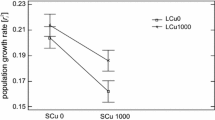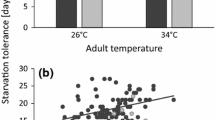Abstract
Multi-generation exposure of organisms to toxicants may lead to adaptations increasing their resistance to a chemical. However, the increased tolerance may have a negative effect on fitness in uncontaminated environments due to increased maintenance costs in adapted individuals. Herein we present results of a multi-generation experiment on the flour beetle, Tribolium confusum, showing that animals bred for ca. 10–13 generations in copper-contaminated medium had higher maintenance costs then their counterparts originating from uncontaminated medium. The results show that significant changes in energy budgets may occur even after relatively short selection in small laboratory cultures.

Similar content being viewed by others
References
Calow P (1991) Physiological costs of combating chemical toxicants: ecological implications. Comp Biochem Physiol C 100:3–6
Comoglio LI, Gaxiola G, Roque A, Cuzon G, Amin O (2004) The effect of starvation on refeeding, digestive enzyme activity, oxygen consumption, and ammonia excretion in juvenile white shrimp Litopenaeus vannamei. J Shellfish Res 23:243–249
Conradi M, Depledge MH (1998) Population responses of the marine amphipod Corophium volutator (Pallas, 1766) to copper. Aquat Toxicol 44:31–45
Kramarz P, Kafel A (2003) The respiration rate of the beet armyworm pupae (Spodoptera exigua) after multi-generation intoxication with cadmium and zinc. Environ Pollut 126:1–3
Łagisz M, Kramarz P, Niklińska M (2005) Metal kinetics and respiration rates in F1 generation of carabid beetles (Pterostichus oblongopunctatus F.) originating from metal-contaminated and reference areas. Arch Environ Contam Toxicol 48:484–489
Łagisz M, Laskowski R (2002) Respiratory metabolism in Pterostichus oblongopunctatus originating from metal contaminated and reference areas. Fresenius Environ Bull 11:74–77
Laskowski R, Maryański M, Pyza E, Wojtusiak J (1996) Sublethal toxicity tests for long-lived invertebrates: searching for a solution. In: Van Straalen NM, Krivolutsky DA (eds) Bioindicator systems for soil pollution NATO ASI Series, 2: environment. Kluwer, Dordrecht, p 45–55
Migula P (1986) Combined and separate effects of cadmium, lead and zinc on respiratory metabolism during the last larval stage of the house cricket, Acheta domesticus. Biologia (Bratislava) 44:513–521
Posthuma L, Van Straalen NM (1993) Heavy metal adaptation in terrestrial invertebrates: a review of occurence, genetics, physiology and ecological consequences. Comp Biochem Physiol C 106:11–38
Rowe CL, Hopkins WA, Zehnder C, Congdon JD (2001) Metabolic costs incurred by crayfish Procambarus acutus in a trace element-polluted habitat: further evidence of similar responses among diverse taxonomic groups. Comp Biochem Physiol C 129:275–283
Shirley MD, Sibly RM (1999) Genetic basis of a between-environment trade-off involving resistance to cadmium in Drosophila melanogaster. Evolution 53:826–836
Sibly RM, Calow P (1989) The life-cycle theory of responses to stress. Biol J Linn Soc 37:101–116
Simcic T, Lukancic S, Brancelj A (2005) Comparative study of electron transport system activity and oxygen consumption of amphipods from caves and surface habitats. Freshw Biol 50:494–501
Sokoloff A (1974) The biology of Tribolium, vol. 2. Clarendon Press, Oxford, UK
Stone D, Jepson P, Kramarz P, Laskowski R (2001) Time to death response in carabid beetles exposed to multiple stressors along a gradient of heavy metal pollution. Environ Pollut 113:239–244
Van Straalen NM, Hoffmann AA (2000) Review of experimental evidence for physiological costs of tolerance to toxicants. In: Kammenga JE, Laskowski R (eds) Demography in Ecotoxicology. Wiley, Chichester, p 147–162
Wilson JB (1988) The cost of heavy-metal tolerance: an example. Evolution 42:408–413
Xie L, Klerks PL (2004) Fitness cost of resistance to cadmium in the least killifish (Heterandria formosa). Environ Toxicol Chem 23:1499–1503
Zygmunt PMS (2006) Bioenergetics of the grasshopper Euthystira brachyptera originating from metal pollution gradient. In: Book of abstracts of international conference on ecotoxicology: Trends and Perspectives, Wisła, p 148
Acknowledgments
This study was financially supported by the Jagiellonian University, grant no. DS-758.
Author information
Authors and Affiliations
Corresponding author
Rights and permissions
About this article
Cite this article
Lukasik, P., Laskowski, R. Increased Respiration Rate as a Result of Adaptation to Copper in Confused Flour Beetle, Tribolium confusum Jacquelin du Val. Bull Environ Contam Toxicol 79, 311–314 (2007). https://doi.org/10.1007/s00128-007-9227-2
Received:
Accepted:
Published:
Issue Date:
DOI: https://doi.org/10.1007/s00128-007-9227-2




